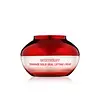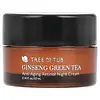What's inside
What's inside
 Key Ingredients
Key Ingredients

 Benefits
Benefits

 Concerns
Concerns

 Ingredients Side-by-side
Ingredients Side-by-side

Water
Skin ConditioningCetyl Ethylhexanoate
EmollientButylene Glycol
HumectantGlycerin
HumectantPropanediol
SolventSqualane
Emollient1,2-Hexanediol
Skin ConditioningNiacinamide
SmoothingCetearyl Alcohol
EmollientArachidyl Alcohol
EmollientLimnanthes Alba Seed Oil
Skin ConditioningCetearyl Olivate
Behenyl Alcohol
EmollientSorbitan Olivate
EmulsifyingMethyl Hydrogenated Rosinate
PerfumingVinyldimethicone
Glycereth-26
HumectantArachidyl Glucoside
EmulsifyingCarbomer
Emulsion StabilisingPolyacrylate-13
Tromethamine
BufferingHydrogenated Polyisobutene
EmollientSodium Polyacrylate
AbsorbentTocopheryl Acetate
AntioxidantAgar
MaskingEthylhexylglycerin
Skin ConditioningAdenosine
Skin ConditioningCalcium Alginate
MaskingPolyglyceryl-10 Laurate
Skin ConditioningCaprylic/Capric Triglyceride
MaskingEthylhexyl Palmitate
EmollientDisodium EDTA
Sorbitan Isostearate
EmulsifyingCoccinia Indica Fruit Extract
Skin ConditioningEclipta Prostrata Extract
Skin ConditioningHydrogenated Lecithin
EmulsifyingMacadamia Ternifolia Seed Oil
EmollientMica
Cosmetic ColorantTitanium Dioxide
Cosmetic ColorantSynthetic Fluorphlogopite
Ceramide NP
Skin ConditioningHyaluronic Acid
HumectantRetinol
Skin ConditioningAcrylates/C10-30 Alkyl Acrylate Crosspolymer
Emulsion StabilisingAmmonium Polyacryloyldimethyl Taurate
Emulsion StabilisingCollagen Extract
Skin ConditioningHydrolyzed Hyaluronic Acid
HumectantSodium Hyaluronate
HumectantBrassica Campestris Sterols
EmollientCI 77491
Cosmetic ColorantCholesterol
EmollientPhytosteryl/Behenyl/Octyldodecyl Lauroyl Glutamate
Skin ConditioningCarnosine
Skin ConditioningPolylactic Acid
AbrasiveAluminum/Magnesium Hydroxide Stearate
Emulsion StabilisingHydrolyzed Elastin
EmollientPentaerythrityl Tetra-Di-T-Butyl Hydroxyhydrocinnamate
AntioxidantChitosan
Cyperus Rotundus Root Extract
Skin ConditioningTin Oxide
AbrasiveTris(Tetramethylhydroxypiperidinol)Citrate
StabilisingSilica
AbrasiveColloidal Gold
AntimicrobialGold
Cosmetic ColorantWater, Cetyl Ethylhexanoate, Butylene Glycol, Glycerin, Propanediol, Squalane, 1,2-Hexanediol, Niacinamide, Cetearyl Alcohol, Arachidyl Alcohol, Limnanthes Alba Seed Oil, Cetearyl Olivate, Behenyl Alcohol, Sorbitan Olivate, Methyl Hydrogenated Rosinate, Vinyldimethicone, Glycereth-26, Arachidyl Glucoside, Carbomer, Polyacrylate-13, Tromethamine, Hydrogenated Polyisobutene, Sodium Polyacrylate, Tocopheryl Acetate, Agar, Ethylhexylglycerin, Adenosine, Calcium Alginate, Polyglyceryl-10 Laurate, Caprylic/Capric Triglyceride, Ethylhexyl Palmitate, Disodium EDTA, Sorbitan Isostearate, Coccinia Indica Fruit Extract, Eclipta Prostrata Extract, Hydrogenated Lecithin, Macadamia Ternifolia Seed Oil, Mica, Titanium Dioxide, Synthetic Fluorphlogopite, Ceramide NP, Hyaluronic Acid, Retinol, Acrylates/C10-30 Alkyl Acrylate Crosspolymer, Ammonium Polyacryloyldimethyl Taurate, Collagen Extract, Hydrolyzed Hyaluronic Acid, Sodium Hyaluronate, Brassica Campestris Sterols, CI 77491, Cholesterol, Phytosteryl/Behenyl/Octyldodecyl Lauroyl Glutamate, Carnosine, Polylactic Acid, Aluminum/Magnesium Hydroxide Stearate, Hydrolyzed Elastin, Pentaerythrityl Tetra-Di-T-Butyl Hydroxyhydrocinnamate, Chitosan, Cyperus Rotundus Root Extract, Tin Oxide, Tris(Tetramethylhydroxypiperidinol)Citrate, Silica, Colloidal Gold, Gold
Water
Skin ConditioningGlycerin
HumectantCaprylic/Capric Triglyceride
Masking1,2-Hexanediol
Skin ConditioningPanthenol
Skin ConditioningSimmondsia Chinensis Seed Oil
EmollientSodium Polyacrylate
AbsorbentRetinol
Skin ConditioningTocopheryl Acetate
AntioxidantSodium Hyaluronate
HumectantHydroxyacetophenone
AntioxidantPanax Ginseng Root Extract
EmollientPropanediol
SolventCamellia Sinensis Leaf Extract
AntimicrobialCaprylhydroxamic Acid
Rosa Damascena Flower Water
MaskingCucumis Sativus Fruit Extract
EmollientPropylene Glycol
HumectantChamomilla Recutita Flower Extract
MaskingAloe Barbadensis Leaf Juice
Skin ConditioningWater, Glycerin, Caprylic/Capric Triglyceride, 1,2-Hexanediol, Panthenol, Simmondsia Chinensis Seed Oil, Sodium Polyacrylate, Retinol, Tocopheryl Acetate, Sodium Hyaluronate, Hydroxyacetophenone, Panax Ginseng Root Extract, Propanediol, Camellia Sinensis Leaf Extract, Caprylhydroxamic Acid, Rosa Damascena Flower Water, Cucumis Sativus Fruit Extract, Propylene Glycol, Chamomilla Recutita Flower Extract, Aloe Barbadensis Leaf Juice
Ingredients Explained
These ingredients are found in both products.
Ingredients higher up in an ingredient list are typically present in a larger amount.
1,2-Hexanediol is a synthetic liquid and another multi-functional powerhouse.
It is a:
- Humectant, drawing moisture into the skin
- Emollient, helping to soften skin
- Solvent, dispersing and stabilizing formulas
- Preservative booster, enhancing the antimicrobial activity of other preservatives
This ingredient is an emollient, solvent, and texture enhancer. It is considered a skin-softener by helping the skin prevent moisture loss.
It helps thicken a product's formula and makes it easier to spread by dissolving clumping compounds.
Caprylic Triglyceride is made by combining glycerin with coconut oil, forming a clear liquid.
While there is an assumption Caprylic Triglyceride can clog pores due to it being derived from coconut oil, there is no research supporting this.
Learn more about Caprylic/Capric TriglycerideGlycerin is already naturally found in your skin. It helps moisturize and protect your skin.
A study from 2016 found glycerin to be more effective as a humectant than AHAs and hyaluronic acid.
As a humectant, it helps the skin stay hydrated by pulling moisture to your skin. The low molecular weight of glycerin allows it to pull moisture into the deeper layers of your skin.
Hydrated skin improves your skin barrier; Your skin barrier helps protect against irritants and bacteria.
Glycerin has also been found to have antimicrobial and antiviral properties. Due to these properties, glycerin is often used in wound and burn treatments.
In cosmetics, glycerin is usually derived from plants such as soybean or palm. However, it can also be sourced from animals, such as tallow or animal fat.
This ingredient is organic, colorless, odorless, and non-toxic.
Glycerin is the name for this ingredient in American English. British English uses Glycerol/Glycerine.
Learn more about GlycerinPropanediol is an all-star ingredient. It softens, hydrates, and smooths the skin.
It’s often used to:
Propanediol is not likely to cause sensitivity and considered safe to use. It is derived from corn or petroleum with a clear color and no scent.
Learn more about PropanediolRetinol is a gold-standard ingredient for anti-aging. It is a form of Vitamin A and belongs to the class of retinoids that also includes tretinoin.
Why is retinol famous?
It has the most scientific studies backing up its skin benefits out of all the non-prescription ingredients.
Retinol is proven to:
This is why retinol is effective at removing wrinkles, fading dark spots, treating acne, and reducing the appearance of pores.
Studies show retinol is less effective when exposed to UV. Be sure to look for appropriate packaging to keep your retinol potent (similar to Vitamin C).
Using retinol or any retinoids will increase sun-sensitivity in the first few months. Though studies show retinoids increase your skin's natural SPF with continuous use, it is best to always wear sunscreen and sun-protection.
We recommend speaking with a medical professional about using this ingredient during pregnancy.
Retinol may cause irritation in some people, so be sure to patch test. Experts recommend 'ramping up' retinol use: start using this ingredient once a week and work up to using it daily.
Read about Tretinoin
Learn more about RetinolSodium Hyaluronate is hyaluronic acid's salt form. It is commonly derived from the sodium salt of hyaluronic acid.
Like hyaluronic acid, it is great at holding water and acts as a humectant. This makes it a great skin hydrating ingredient.
Sodium Hyaluronate is naturally occurring in our bodies and is mostly found in eye fluid and joints.
These are some other common types of Hyaluronic Acid:
Learn more about Sodium HyaluronateSodium Polyacrylate is the sodium salt of polyacrylic acid. It is used as an absorber, emollient, and stabilizer.
This ingredient is a super-absorbent polymer - meaning it can absorb 100 to 1000 times its mass in water. As an emollient, Sodium Polyacrylate helps soften and soothe skin. Emollients work by creating a barrier to trap moisture in. This helps keep your skin hydrated.
Tocopheryl Acetate is AKA Vitamin E. It is an antioxidant and protects your skin from free radicals. Free radicals damage the skin by breaking down collagen.
One study found using Tocopheryl Acetate with Vitamin C decreased the number of sunburned cells.
Tocopheryl Acetate is commonly found in both skincare and dietary supplements.
Learn more about Tocopheryl AcetateWater. It's the most common cosmetic ingredient of all. You'll usually see it at the top of ingredient lists, meaning that it makes up the largest part of the product.
So why is it so popular? Water most often acts as a solvent - this means that it helps dissolve other ingredients into the formulation.
You'll also recognize water as that liquid we all need to stay alive. If you see this, drink a glass of water. Stay hydrated!
Learn more about Water